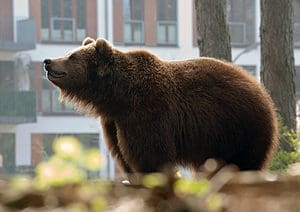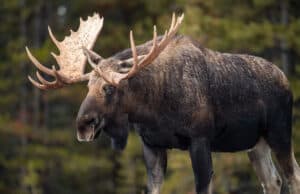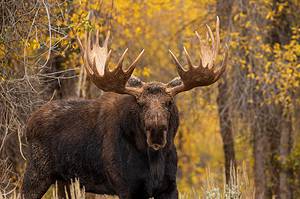The moose is the largest animal in the deer family and is also known as elk in other countries. It is a part of the New World deer subfamily, and mostly inhabits forests and sub-arctic climates in the Northern Hemisphere. Moose mostly feed off vegetation found both in water and on dry land. Despite being incredibly large and heavy, they also have quite a few predators. Bears, wolves, and humans are known to hunt these massively beautiful creatures. However, when these majestic beasts are frightened, they can put up quite a fight. Their antlers alone can cause significant damage. More so, their massive bodies and strong, fast legs also aid in defense. Join us as we uncover 10 incredible moose facts!

1. Moose Weigh Over 1,000 Lbs.

Moose are the largest of the deer species and are also the heaviest.
©iStock.com/RichardSeeley
Not only are moose the largest of the deer species, but they are also the heaviest. On average, a male moose weighs around 1,200 pounds but can vary anywhere between 900-1,800 pounds. A female moose can weigh anywhere from 400 pounds to 1,100 pounds, with their calves being born at a sturdy 30 pounds on average. Once they are grown, it is said that their antlers alone can weigh up to 40 pounds!
2. Moose Can Run Faster Than Humans
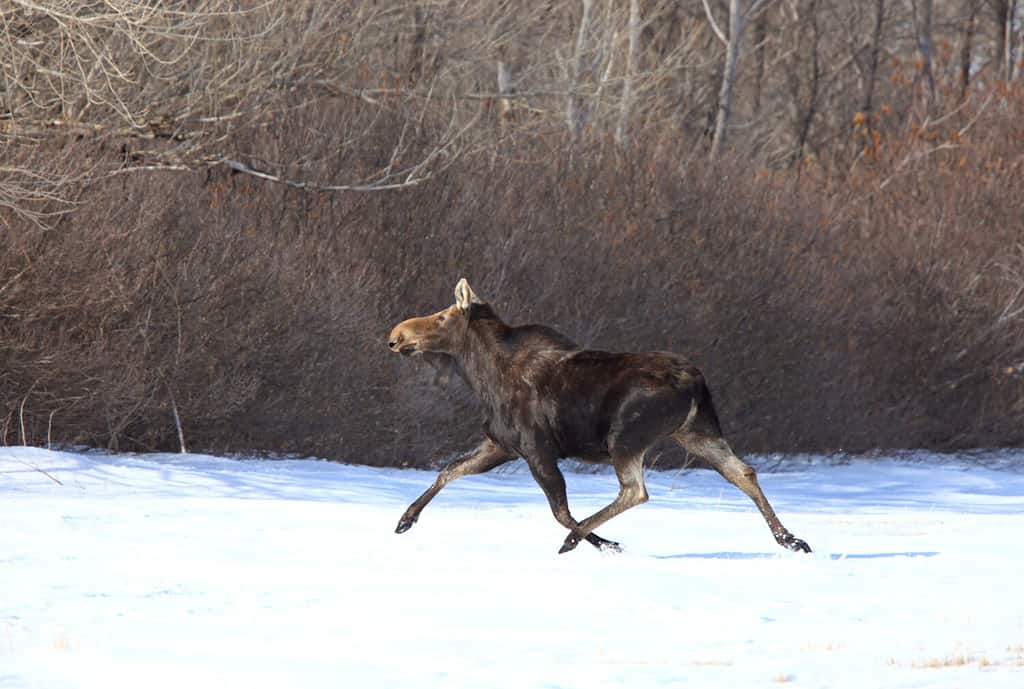
Moose are surprisingly fast!
©Pictureguy/Shutterstock.com
Even though moose are quite large and heavy, that doesn’t mean they aren’t great runners. In fact, moose are incredibly fast! They run a lot faster than humans, clocking at a speed of 35 mph. Although they can reach over 6 feet in height, their long legs are quite thin, so they try to run as much as possible to maintain a long and healthy life, eliminating the chance of developing arthritis or osteoporosis.
3. Moose Can Dive
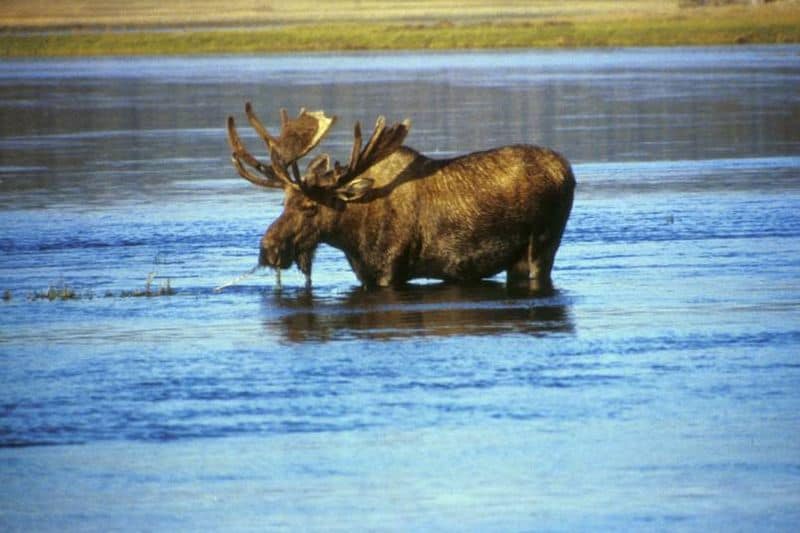
Moose dive and swim to cool off.
©Mike.lifeguard – Public Domain
During hot seasons and warmer temperatures, moose love to cool off by swimming, which is perfect for them because not only are they great swimmers, but rather excellent divers as well! They can dive up to 20ft underwater and can hold their breath for a minute. Because their nostrils are so large, they can almost function as valves, blocking out any water and allowing them to stay underwater for longer periods of time. They don’t just dive to cool their bodies; they also search for aquatic vegetation. Moose do not even have to wait until they rise above the water surface to chew or swallow either!
4. One Moose Predator Is the Killer Whale
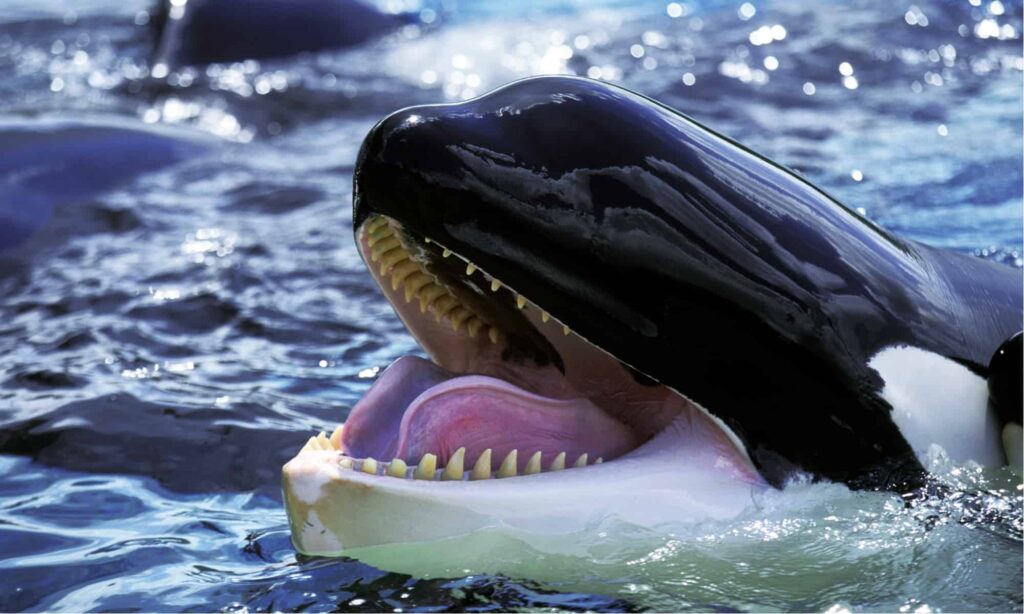
Killer whales will attack moose that get too close to some ocean coasts.
©slowmotiongli/Shutterstock.com
This is a little-known moose fact! Because moose rely on aquatic vegetation as well, they are often near water in the northern hemisphere, meaning they can swim in ocean water and dive for food sources. Because of this, bears and wolves aren’t their only predators. In fact, there have been several reports from witnesses and scientists that have seen wild Orcas often attacking and feeding on both deer and moose!
5. Moose Are Rarely Aggressive
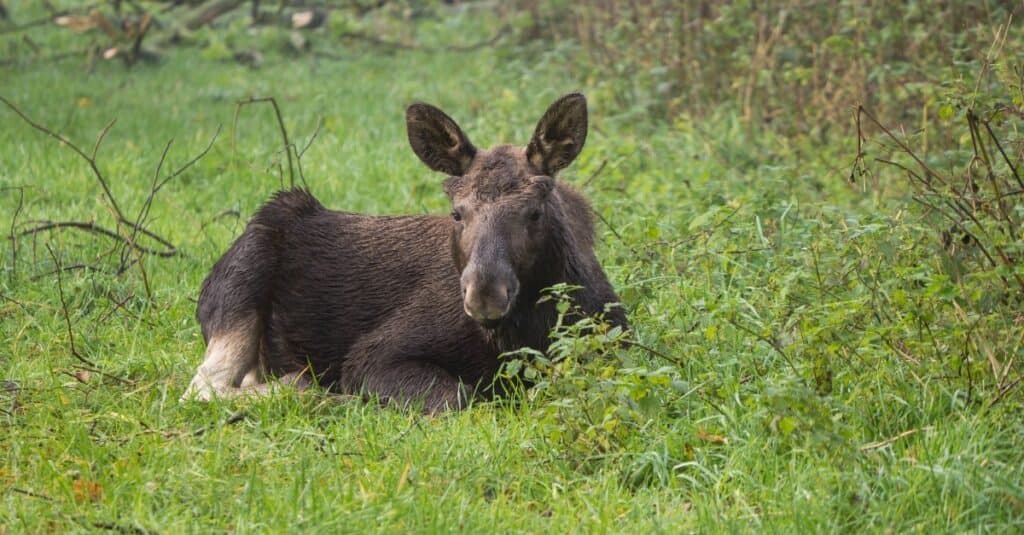
Though intimidating, moose are generally docile in nature.
©iStock.com/hipproductions
Moose have a bad reputation for being labeled as aggressive wild animals. They like to live peacefully and away from other animals and especially humans. However, if they are attacked or harassed, they will fight back. If you spot them in the wild, it is best to maintain an overly broad distance away from them. If you notice a moose becoming increasingly irritated, this could mean that you have gotten too close.
6. Moose Are Not Very Social

You generally will not see multiple moose at one time.
©Harry Collins Photography/Shutterstock.com
Moose like to live in peaceful solitude, and because of this, they are considered one of the least social animals on the planet. They typically spend most of their lives alone, except for mating season. During this time, there may be active groups of both male and female moose, often competing for a mate. Once they have reproduced, the mother will stay with the young for a brief time before eventually splitting apart and starting the cycle over again.
7. Moose Are Herbivores
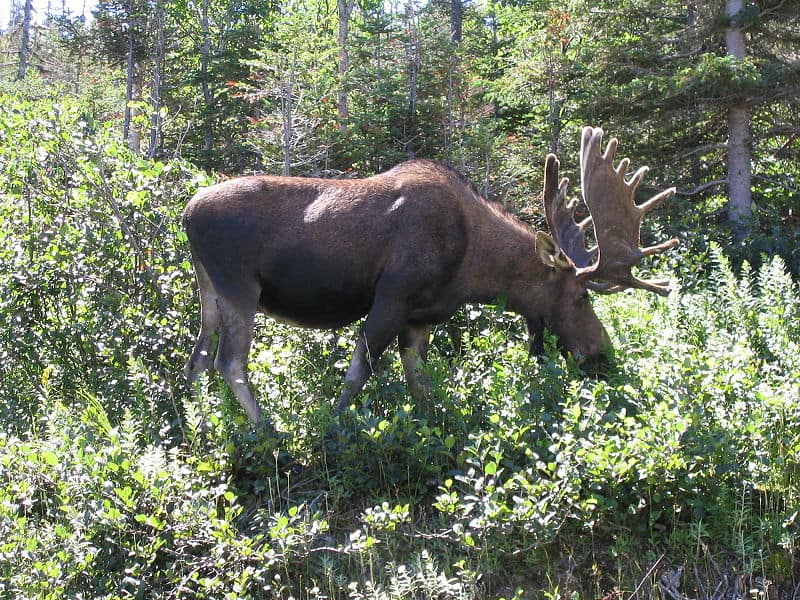
With a diet comprised of vegetation, moose are vegetarian.
©Aconcagua / CC BY-SA 3.0, via Wikimedia Commons – Original / License
Moose feed both on terrestrial and aquatic vegetation. Their diet consists of a wide variety of fruits, nuts, seeds, and plants. However, their diet changes depending on location and seasons. Regardless of where they reside, on average, an adult moose eats up to forty pounds of plant matter per day. Because their diet heavily relies on the changing of seasons, moose will typically eat larger amounts before the winter months, storing as many fat reserves as possible for when the plants die during the cold season. When spring blooms and more plant sources become available, moose will seek out as many plants, tall grasses, and fruits as possible.
8. Moose Are Found in Meadows and Forests
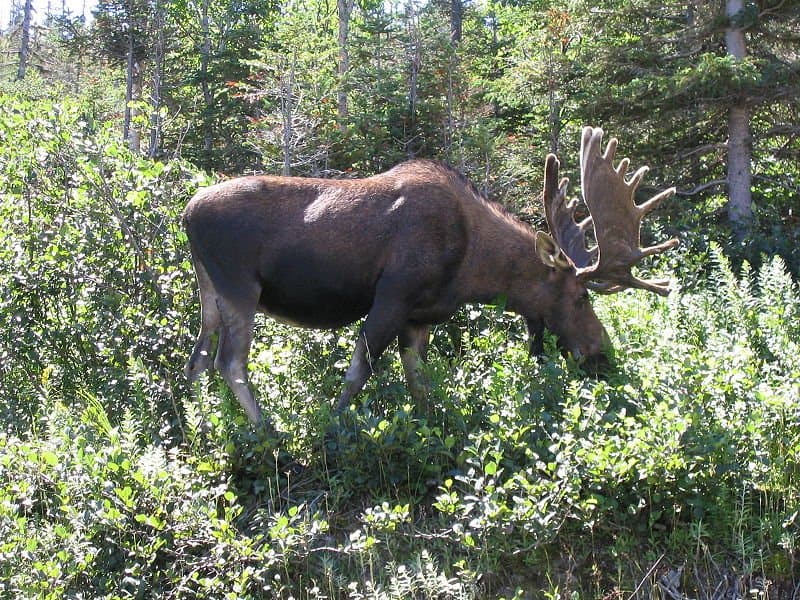
Moose have a vegetarian diet.
©Aconcagua / Creative Commons – Original
Because moose are mostly found in the northern hemisphere, they almost always reside in forests or large areas rich with both vegetation and trees. Since they feed off aquatic vegetation, they are also commonly found nearby lakes, swamps, rivers, and open water. In the United States, they are mostly found in Alaska, Washington, and Maine. They are also quite common in Canada and Europe. However, in Europe, they are mostly referred to as elk.
9. Moose Antlers Fall Off Every Winter
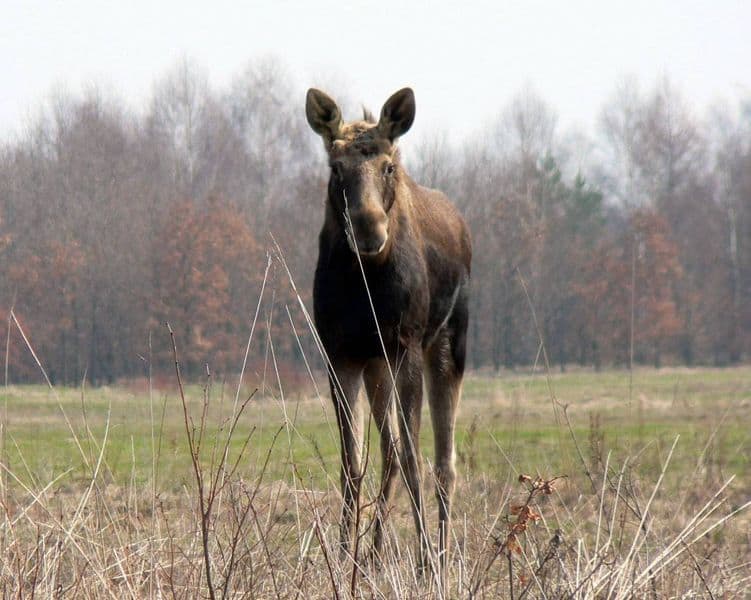
After shedding their antlers, it takes a few months for moose to grow them back.
©Wojsyl / Creative Commons – Original
Moose shed their antlers every winter between mid-November and early March. Once their antlers shed and hit the ground, they will begin to decompose and even serve as a protein source for ground animals such as squirrels. On average, it takes a moose around 2 to 3 months for them to grow a new pair. However, when they are young, they will not grow antlers until they are at least two years old.
10. Moose Reside in North America, Europe, and Russia
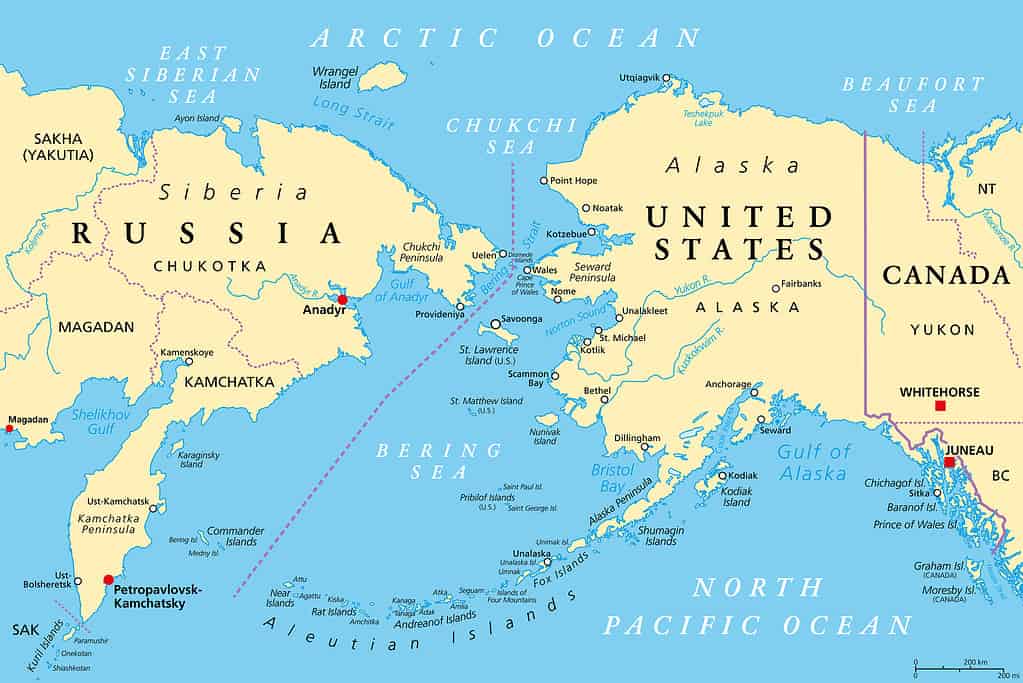
Moose can be found in the Northern Hemisphere.
©PeterHermesFurian/ via Getty Images
Since moose reside in the northern hemisphere, they reside in North America, Europe, and Russia. In fact, in Europe, they are often referred to as elk, whereas in Canada, they are commonly called rubber-nosed swamp donkeys, but those aren’t the only places that have had unique names or use for these large animals. In the Soviet Union, moose were said to once attempted to be domesticated and used as a form of cavalry or military group during the time of Joseph Stalin’s reign. However, this fact is often referred to as a hoax, but apparently, anything is possible for the rubber-nosed swamp donkey.
The photo featured at the top of this post is © iStock.com/pum_eva
Thank you for reading! Have some feedback for us? Contact the AZ Animals editorial team.




